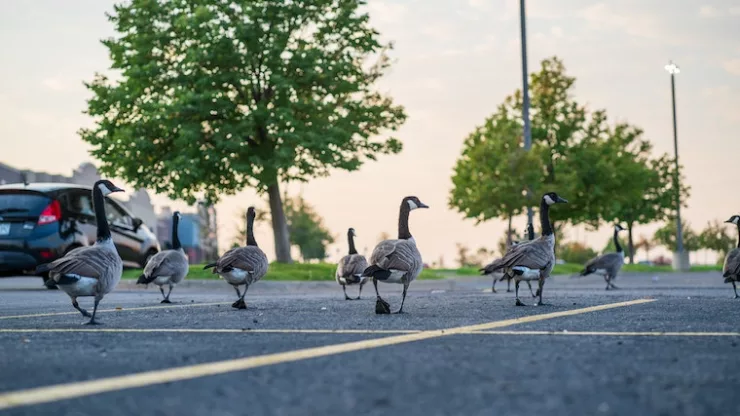Wild turkeys have long been associated with rural areas, but in recent years, these birds have been making their way into urban landscapes.
The phenomenon of urbanized wild turkeys has become more prevalent across the United States, and this article explores the reasons why and their impact on urban areas.
Jump to Section
Introduction
Wild turkeys, once considered solely rural creatures, are now becoming a common sight in urban areas across the United States.
As the natural habitat of these birds is continually threatened, they are adapting to urban environments.
This article delves into the history, behavior, benefits, drawbacks, and future of urban turkeys.
Why are wild turkeys urbanizing?
There are several reasons why wild turkeys are moving into urban areas.
One of the main reasons is the destruction of their natural habitat due to urbanization and human activity.
As their natural habitats are destroyed, they are forced to seek out new habitats, and urban areas provide an ideal alternative.
Additionally, urban areas offer a steady food supply, protection from predators, and a warmer climate.
What is the impact of wild turkeys on urban areas?
The impact of wild turkeys on urban areas can be both positive and negative.
On the one hand, they contribute to the biodiversity of urban areas and can even help control insect populations.
On the other hand, they can cause property damage, create traffic hazards, and become a nuisance to residents.
Turkeys Take the Town: A Brief History
How did wild turkeys become urbanized?
Wild turkeys have adapted to urban environments over time due to the destruction of their natural habitats and an abundance of food sources in urban areas.
These birds have learned to overcome their fear of humans and have become comfortable in urban environments.
When did wild turkeys start appearing in urban areas?
The first recorded sighting of wild turkeys in an urban environment was in 1968 in Staten Island, New York.
Since then, wild turkeys have slowly made their way into urban areas across the United States.
Where are wild turkeys most commonly found in urban areas?
Wild turkeys are most commonly found in suburban and rural-urban fringe areas, where there is a mix of urban and natural environments.
They tend to avoid heavily urbanized areas and prefer areas with green spaces and tree cover.
Urban Turkey Behavior
How do wild turkeys behave in urban areas compared to rural areas?
Wild turkeys behave differently in urban environments than in rural areas. They tend to be less fearful of humans and are less likely to flee when approached.
Additionally, they have become accustomed to the sounds of urban areas and are less likely to be startled by loud noises.
What are some common behaviors of urban turkeys?
Urban turkeys can exhibit a range of behaviors, from foraging in parks and yards to perching on roofs and cars.
They may also become aggressive towards humans and pets during breeding season and can cause damage to property.
The Benefits and Drawbacks of Urban Turkeys
Benefits of urban turkeys
Urban turkeys contribute to the biodiversity of urban areas and can help control insect populations.
They also provide an opportunity for residents to observe and appreciate wildlife in urban areas.
Drawbacks of urban turkeys
Urban turkeys can cause property damage, create traffic hazards, and become a nuisance to residents. They can also spread diseases and parasites to humans and pets.
| Pros | Cons |
|---|---|
| Contribute to biodiversity | Property damage |
| Control insect populations | Traffic hazards |
| Opportunity to observe wildlife | Nuisance to residents |
| Spread diseases and parasites |
The Future of Urban Turkeys
Will the trend of urban turkeys continue?
As long as the natural habitats of wild turkeys continue to be threatened, the trend of urban turkeys is likely to continue.
However, as urban areas continue to expand, the potential for conflicts between humans and wild turkeys may increase.
What is being done to manage urban turkey populations?
Several measures are being taken to manage urban turkey populations, including relocating birds to more suitable habitats, implementing feeding bans, and educating the public on how to coexist with urban turkeys.
Conclusion: The Urbanization of Wild Turkeys
The urbanization of wild turkeys is a fascinating phenomenon that highlights the adaptability of wildlife to changing environments.
While there are both benefits and drawbacks to their presence in urban areas, it is important to find a way to coexist with these birds in a way that is both safe and sustainable.
Final thoughts on the future of urban turkeys
As urbanization continues to threaten the natural habitats of wild turkeys, it is important to find ways to manage their populations in urban areas.
By educating the public on how to coexist with urban wildlife, implementing feeding bans, and relocating birds to more suitable habitats, we can ensure the survival of these magnificent creatures for years to come.
FAQ
What should I do if I encounter a wild turkey in my neighborhood?
If you encounter a wild turkey in your neighborhood, it is best to keep your distance and avoid approaching the bird.
If the turkey becomes aggressive, you should contact local wildlife authorities for assistance.
Can I feed wild turkeys in my backyard?
Feeding wild turkeys can contribute to their urbanization and create conflicts between birds and humans.
It is best to avoid feeding wild turkeys in your backyard and instead allow them to forage naturally for food.
Are wild turkeys dangerous to humans?
While wild turkeys are generally not dangerous to humans, they can become aggressive during breeding season and can cause property damage.
It is important to give these birds their space and avoid approaching them.
I’m a nature enthusiast and creator of Metro Wilds and have spent years exploring the great outdoors.
With a passion for environmental conservation and sustainability, I have dedicated my career to writing about the beauty and wonders of nature, as well as the threats facing our planet.
Contact me at [email protected] for assistance.





